Lugares de interés (POIs) del Mapa
0: Sen título

Pyramids of Giza, Egypt

Image Attribution: Merkur*
The Great Pyramid of Giza (Khufu's Pyramid/Pyramid of Cheops), is the oldest and largest of three pyramids in the Giza Necropolis and is the only remaining member of the Seven Wonders of the World. There have been various theories regarding the construction techniques used but the generally accepted idea is that it was built by moving huge stones from a quarry and dragging and lifting them into place.
There are three known chambers inside the structure. The lowest opening is cut into the bedrock upon which the pyramid was built. The 'Queen's Chamber' and 'King's Chamber' are located higher up. Interestingly, the base is not a square but rather a 4 pointed star, each side being slightly concave. This was discovered in 1940, when a British Air Force pilot flew over the site.
Read more about The Pyramids of Giza at Heritage Key
Más sobre Sen título
1: Sen título

Great Pyramid of Giza, Egypt
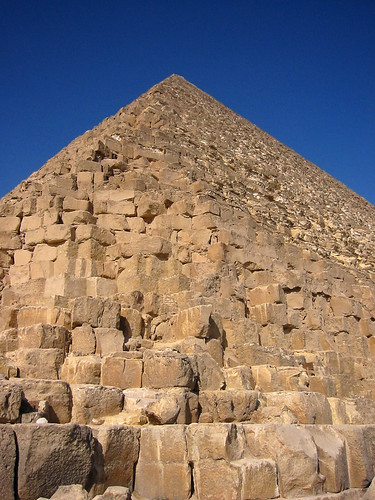
Image Attribution: Mylos
The Great Pyramid of Giza (Khufu's Pyramid/Pyramid of Cheops), is the oldest and largest of three pyramids in the Giza Necropolis and is the only remaining member of the Seven Wonders of the World. There have been various theories regarding the construction techniques used but the generally accepted idea is that it was built by moving huge stones from a quarry and dragging and lifting them into place.
There are three known chambers inside the structure. The lowest opening is cut into the bedrock upon which the pyramid was built. The 'Queen's Chamber' and 'King's Chamber' are located higher up. Interestingly, the base is not a square but rather a 4 pointed star, each side being slightly concave. This was discovered in 1940, when a British Air Force pilot flew over the site.
Read more about The Great Pyramid of Giza at Heritage Key
Más sobre Sen título
2: Sen título

The Great Sphinx, Egypt

Image Attribution: Xavier Fargas
The reclining statue of the Great Sphinx sits to the northeast of Chephren's (Khafra's) Valley Temple on the west bank of the Nile. The soft sandstone forms a body of 200 feet long and 65 feet tall. The face of the sphinx is 13 feet wide and its eyes are 6 feet high. Part of the uraeus (sacred cobra), the nose and the ritual beard are now missing ( the beard is now displayed in the British Museum).
It is likely that the Sphinx was built to represent Chephren. If correct, it would make this monolith the oldest known royal portrait of this scale. (Although it is worth noting that other scholars believe that the style is more indicative of the Pharaoh Khufu (2589-2566 BCE), whilst others would hold that the the body was not originally intended to represent a lion but rather that of a dog or jackel, therefore intending the sculpture to be in the image of the god Anubis.)
Read more about The Great Sphinx at Heritage Key
Más sobre Sen título
3: Sen título

Khafre's Pyramid, Egypt
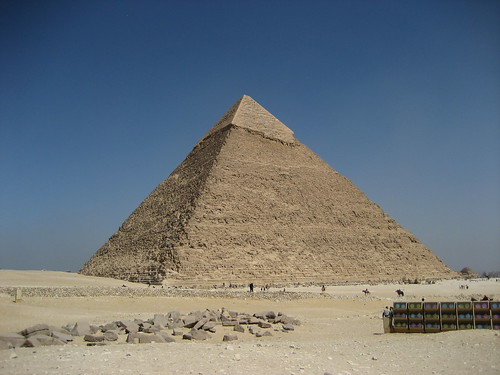
Image Attribution: a rancid amoeba
The Pyramid of Khafre was ordered by Pharaoh Khafre, to be built next to that of his father, Khufu, (The Great Pyramid). The Dimensions of this pyramid are: Angle of Slope: 53 degrees, height: 471 feet, base Lenght: 705 feet and although it is smaller than Khufu's, it appears taller by its placing on top of a foundation of bedrock that was about 33 feet higher than that of his father.
However there is a noticeable flaw in its shape, there is a slight twist at the top that is due to the fact that the four corner angles were not aligned correctly to meet at the top. The top also has a different color and texture than the rest of the structure and the other pyramids around it.
This section is what remains of the casing stones that once covered the entire pyramid. Only the top escaped the plunderers that took the fine limestone sections that were most accessible to steal. Interestingly the pyramid is actually part of the Sphinx temple complex. The Sphinx was cut directly from the bedrock at the base of the pyramid and the stones that were removed were probably used to build the pyramid itself.
Read more about Khafre's Pyramid at Heritage Key
Más sobre Sen título
4: Sen título

Menkaure's Pyramid, Egypt
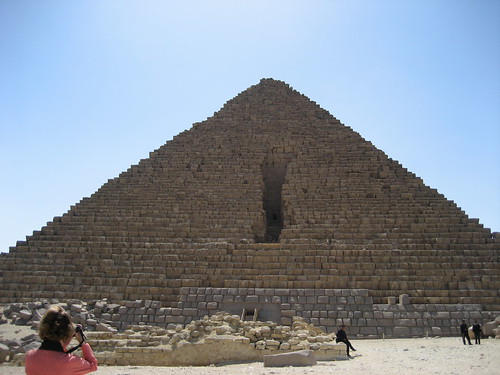
Image Attribution: a rancid amoeba
Menkaure's Pyramid is the smallest of the three Pyramids of Giza, located on the Giza Plateau just outside Cairo. It was built some time in the 26th century BC, and served as a tomb for the fourth dynasty Pharaoh Menkaure. It is much smaller than its neighbours in the Giza necropolis; this may be because by the time of its construction the ancient Egyptians placed more emphasis on temples than the actual pyramids.
At 61m tall (with a former height of 65m) and with a base of 106m, the pyramid is made mainly from limestone. Yet its first 16 courses are built from granite; possibly because the craftsman wished to set the building apart from its neighbours. The granite appears to end suddenly, suggesting maybe that it ran out, or that the Pharaoh's death interrupted proceedings. Menkaure's son Shepseskaf completed much of the complex, including the adjacent Valley Temple and the causeway leading to the Mortuary Temple; it has even been speculated that the building continued after Shepseskaf's death, into the stelae of Merenre I and Pepi I.
Read more about Menkaure's Pyramid at Heritage Key
Más sobre Sen título
5: Sen título

Pyramid of Djoser, Egypt

Image Attribution: Xavier Fargas
The Pyramid of Djoser (Zoser), also known as the step pyramid, is an archeological remain in the Saqqara necropolis, which once served the ancient Egyptian capital Memphis.
This first Egyptian pyramid consisted of six mastabas (of decreasing size) built on top of each another. The pyramid originally stood 62m high, and had a base of 109 x 125m. The step pyramid was clad in polished white limestone and is considered to be one of the earliest large-scale stone constructions.
Read more about The Pyramid of Djoser at Heritage Key
Más sobre Sen título
6: Sen título

Valley of the Kings, Luxor, Egypt

Image Attribution: Jimmy Swift
Standing on the west bank of the Nile, across from ancient Thebes (now Luxor), the Valley of the Kings is one of Egypts most sensitive archaeological sites. Further discoveries in 2005 and 2008 have put the total number of tombs in the necropolis at 63 and these range from simple, single pits to lavish complexes, the largest of which comprises 120 chambers.
The tombs contain important artwork helping scholars to piece together information about ancient Egyptian burial rites and beliefs and, although most of the tombs were plundered centuries ago, they still convey the oppulence and luxury which characterised the lives of their occupants. The first tombs in the valley are thought to belong to Amenhotep I and Thutmose I, whose tomb bears notes recording that its location was selected by the king's adviser, Ineni. Further tombs are cut into the peak of al-Qurn, which would once have been guarded by special tomb police.
Read more about The Pyramids of Giza at Heritage Key
Más sobre Sen título
7: Sen título

Temple of Queen Hatshepsut, Egypt
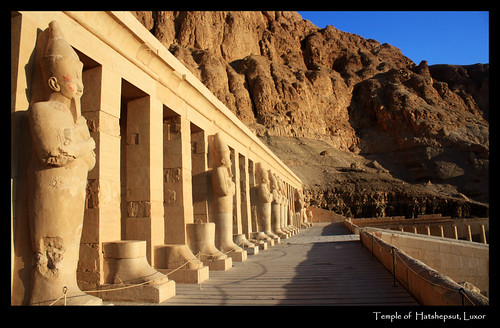
Image Attribution: neptune000
Queen Hatshepsut's extensive temple is built into a mountainside and is composed of three terraces connected by two ramps. Columns decorated with Osirian statues of the Queen line the portico.
The grand scale and careful detail characteristic of the temple is in no doubt reflected by the architects love for Hatshepsut. Indeed, temple architect Senmut was both Hatshepsut's lover and a member of her court.
Read more about The Temple of Queen Hatshepsut at Heritage Key
Más sobre Sen título
8: Sen título

Valley of the Queens, Egypt
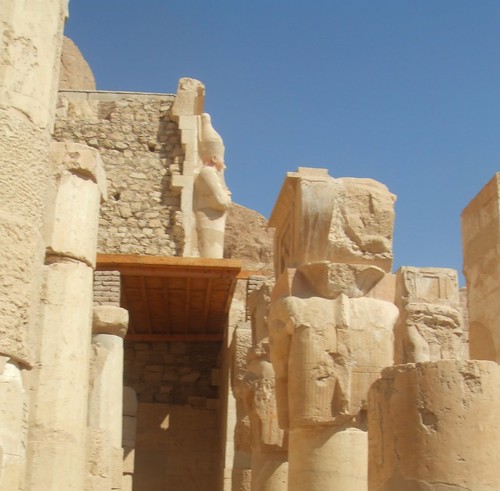
Image Attribution: Phil of Photos
Known as Ta-Set-Neferu ('the place of the children of the pharaoh') in ancient times, the Valley of the Queens contained a wealth of tombs and mortuary chapels where priests carried out daily rituals to mourn and commemorate the dead. Lying on the west bank of the Nile near ancient Thebes, the site is near the Valley of the Kings where the pharaohs of the 18th Dynasty were buried.
There are more than seventy tombs in this vast necropolis, of which the tomb of Queen Nefertari (1290-1224 BC), beloved wife of Ramesses II, is perhaps one of the best known.
Read more about The Valley of the Queens at Heritage Key
Más sobre Sen título
9: Sen título

Ancient Thebes, Egypt
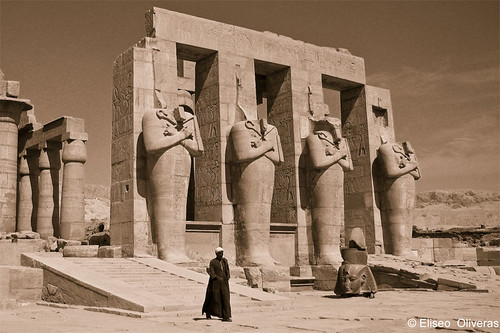
Image Attribution: Elisio Oliveras
Located in Upper Egypt, about 800 km south of the Mediterranean, Thebes was known as Niwt-imn (The City of Amun) during the time of the New Kingdom, the name by which it is referred to in the Old Testament of The Bible. The city was associated with the God Amon Ra and was also know as the city of the 100 gates.
It played a strategic role in many of the political upheavals of Ancient Egypt, including the expulsion of the Hyksos from Upper Egypt. Nowadays, the site is best known for the mortuary temples and tombs of the ancient Egyptian digintaries and the Valleys of the Kings and Queens, which lie on the outskirts of Luxor, Thebes' modern-day equivalent.
Read more about Ancient Thebes at Heritage Key
Más sobre Sen título
10: Sen título

The Ramesseum, Egypt
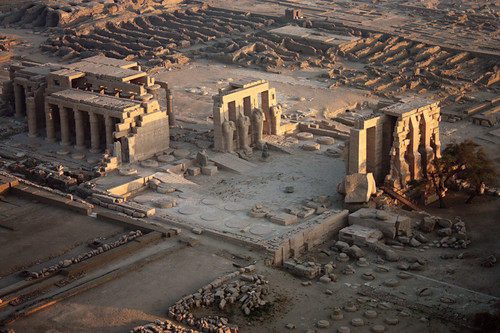
Image Attribution: Paul Beckers
The Ramesseum is the mortuary temple of Pharaoh Ramesses II. It is located in the Theban necropolis in Upper Egypt, across the River Nile from the modern city of Luxor. The name – or at least its French form, Rhamesséion – was coined by Jean-François Champollion, who visited the ruins of the site in 1829 and first identified the hieroglyphs making up Ramesses's names and titles on the walls. It was originally called the 'House of millions of years of Usermaatra-setepenra that unites with Thebes-the-city in the domain of Amon'.
Unlike the massive stone temples that Ramesses ordered carved from the face of the Nubian mountains at Abu Simbel, the inexorable passage of three millennia was not kind to his 'temple of a million years' at Thebes. This was mostly due to its location on the very edge of the Nile floodplain, with the annual inundation gradually undermining the foundations of this temple, and its neighbours. Neglect and the arrival of new faiths also took their toll: for example, in the early years of the Common Era, the temple was put into service as a Christian church.
Read more about The Ramesseum at Heritage Key
Más sobre Sen título
11: Sen título

Siwa Oasis, Egypt
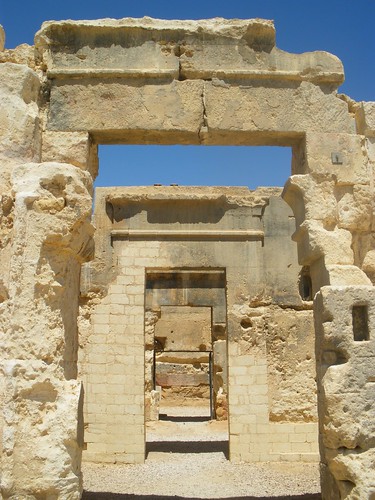
Image Attribution: lindaandandy
Siwa Oasis has been an vital stopping point for caravans crossing the desert since prehistoric times. Although remote, Siwa played an significant role in history as the site of the Oracle of Jupiter Amun. The remains of the Temple of the Oracle and Temple Amun (or Temple of Umm Ubaydah) are testament to Siwa's importance in the ancient world. The nearby Mountain of the Dead, or Gebel el-Mawta contains a number of rock-cut tombs dating from the 3rd Century BC to the 2nd Century AD. Among these is a tomb contain 1500 year old Graeco-Roman mummies.
With the decline of the Roman empire in the 6th Century AD, and the rise of Christianity, the pagan temples of Siwa fell out of use, but the advantageous location of the site meant its importance has continued to the present day.
Read more about The Pyramids of Giza at Heritage Key
Más sobre Sen título
12: Sen título

Nubian Monuments, Egypt
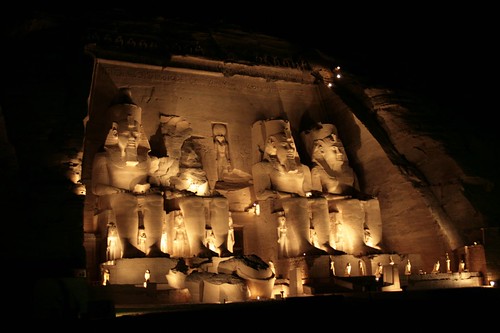
Image Attribution: Marco La Rosa
These enormous twin rock temples are thought to commemorate the Battle of Kadesh and were intended to reinforce the ancient Egyptian religion in Nubia. Although a source of great pride when they were built, the temples fell into disuse over the subsequent generations and by the 6th century BC the statues of the main temple stood knee-deep in sand. They were eventually buried altogether and forgotten until the Swiss explorer JL Buckhardt found part of the main temple's top frieze in 1813.
The site, Abu Simbel, is thought to have been named after a young boy who led the first archaeologists to the site.
Read more about The Nubian Monuments at Heritage Key
Más sobre Sen título
13: Sen título

Abu Mena, Egypt

Image Attribution: nebedaay
Little remains now of this once thriving community. Early excavations turned up the foundations of a large basilica thought to have housed the remains of the saint and the Roman baths. A large dormitory for pilgrims to the shrine has also been found, as have wine presses and a complex to the south where the abbott is thought to have lived.
Read more about Abu Mena at Heritage Key
Más sobre Sen título
14: Sen título

Alexandria, Egypt
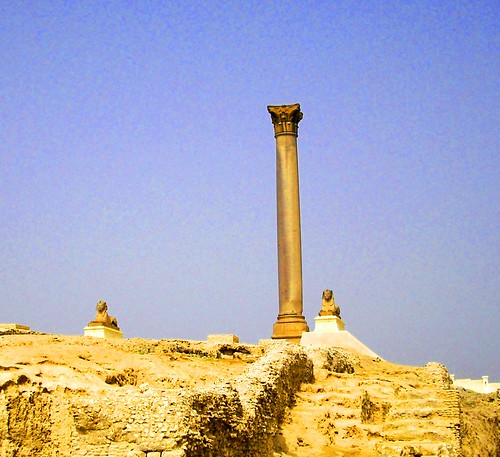
Image Attribution: anarchy for tea
One of the most famous cities of the ancient world, the city of Alexandria was a centre of Hellenism and home to a large jewish community. Its library was once one of the wonders of the ancient world. It's lighthouse - built in the 3rd century BC on the island of Pharos, in the mouth of the harbour - was once one of the Seven Wonders of the World (it collapsed after two earthquakes in the 14th century AD).
Vast parts of the city were destroyed in the Greek-Jewish wars of 115 AD and much has since been lost to earthquakes and modern developments. Nevertheless, the city remains the site of some extraordinary relics.
Read more about Alexandria at Heritage Key
Más sobre Sen título